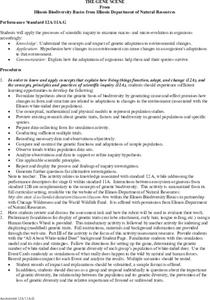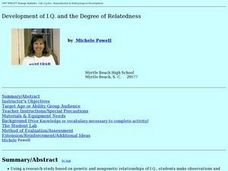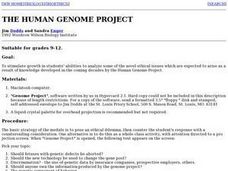Curated OER
Who's the Father?
Students analyze gels to determine parentage in this lesson about scientific evidence, investigation, and DNA concepts. The lesson includes a pre-activity worksheet, a final individual assessment, and student handouts for in-class...
Curated OER
The Gene Scene
High schoolers investigate the concepts of micro and macro evolution. They also research the effects of mutations in the process of genetic adaptation to different environments. They develop a hypothesis of how the environment can...
Curated OER
Genes
Fifth graders learn of how genes transfer information from one generation to the next. They flip a penny and circle traits to create an offspring. Next, they will draw a picture using the traits circled with colored pencils on the "Who...
Curated OER
Extracting DNA
Students explore DNA, genes, chromosomes and the chemicals that make up DNA. They research Internet resources to develop their knowledge of DNA. They conduct an experiment to separate DNA from peas and create a poster that they can use...
Curated OER
Ethics and Reproductive Issues: The Dilemma of Choice
Students research various websites to answer questions and take part in class discussion regarding Prenatal testing. Students listen to an audio file and complete student worksheet. Students discuss different roles of people and...
Curated OER
DNA-a Molecular Identity
Pupils explore about what DNA is and several different DNA typing techniques. They examine three different situations where DNA typing was used to carry out justice. Students also identify and evaluate different uses of DNA typing...
Curated OER
Genes and Aging
Students explore genes and the way we age. They assemble a worm collection device called a Baermann Funnel. Students collect Caenorhabditis elegans or other active nematodes from local soil samples. They observe the appearance and...
Curated OER
Plant Biotechnology: Controlling Tissue Differentiation
Students demonstrate hormonal control of plant tissue differentiation and relate this differentiation to gene expression. They explore the effects of hormones (auxin and cytokinin) on the genes that control tissue differentiation in callus.
Curated OER
Molecular Approaches to Evolution
Students are introduced to working with molecular data. The first activity does both simulated and original data are used to compare amino acid, protein or DNA differences to construct phylogenetic trees or cladograms. These activities...
Curated OER
Cell Transformation in Tobacco Leaf Disks
Students review the basic principles of plant cell structure, tissue culture, sterile technique, and cell transformation. Next students complete a plant transformation experiment using whole plant material in order to view evidence of...
Curated OER
Development of I.Q. and the Degree of Relatedness
Studnets, in groups, analyze data regarding genetic and nongenetic relationships of I.Q. They make observations and discuss correlations from a diagram. Cooperative learning teams discuss a given set of questions and present information...
Curated OER
Teaching Biotechnology by Analogies and Models
Students examine analogies and create models to help visualize the concept and technique of basic biotechnology. Common scenarios are used to explain the complex procedures of genetic engineering.
Curated OER
The Human Geonome Project
Young scholars explore the Human Genome Project (HGP). Students research a fact situation, examine genetic data given, and discuss choices available for a solution. Young scholars consider the ethical question and consequences of each...
Curated OER
Evolution, Genes, and Behavior
Students examine the roles of genes and evolution on behaviors. In groups, they identify the relationships among DNA, genes and chromosomes. They evaluate the different theories of language acquistion and how evolved tendencies interact...
Curated OER
Visualizing a Human Gene with Its Introns & Exons
Learners examine the entire DNA base sequence of the human adenosine deaminase gene after it is printed out from the source disk provided. The enormous length of a single gene as well as the immense difference in length between intron...
Curated OER
From Genomes of Species
High schoolers investigate genomic research being done and its potential for understanding, treating, and possibly curing human genetic conditions. The potential of proteomic research as a companion to the work being done with genomics...
Cold Spring Harbor Laboratory
Dna From the Beginning: Genes Come in Pairs
This animated lesson will explain how genes are inherited in pairs, one from the mother and one from the father.
Cold Spring Harbor Laboratory
Dna From the Beginning: Genes Can Be Turned on and Off
Two French scientists describe the research they did to figure out how bacteria turn certain genes on and off. The topic is a little involved, but the animations should help you understand the process.
Cold Spring Harbor Laboratory
Dna From the Beginning: Genes Are Real Things
Long after Gregor Mendel knew that something controlled heredity three other scientists finally put his research together with new evidence from microscopes to determine that genes do exist. This multimedia article includes animations,...
Cold Spring Harbor Laboratory
Dna From the Beginning: Master Genes Control Body Plans
Homeobox genes are important because they determine the overall body plan for most animals. This article explains the experiments that helped scientists discover these master genes. Article includes animations, pictures, video,...
Cold Spring Harbor Laboratory
Dna From the Beginning
At DNA from the Beginning, choose from classical genetics, molecules of genetics, genetic organization and control. Each concept is explained through animation, an image gallery, video interviews, biographies and links.
Biotechnology Institute
Biotechnology Institute: Your World: Fighting Cancer With Biotechnology [Pdf]
This Biotechnology Institute issue focuses on the role of genetics in cancer. Find out about several types of cancer, the risks, treatments available now, and the treatments of the future.
PBS
Pbs Learning Media: Sweaty T Shirts and Human Mate Choice
This video segment from Evolution: "Why Sex?" explores the "sweaty T-shirt experiment," which showed that humans may unconsciously be drawn toward a specific kind of genetic variation in a mate.
























![Biotechnology Institute: Your World: Fighting Cancer With Biotechnology [Pdf] Article Biotechnology Institute: Your World: Fighting Cancer With Biotechnology [Pdf] Article](https://d15y2dacu3jp90.cloudfront.net/images/attachment_defaults/resource/large/FPO-knovation.png)